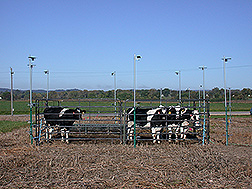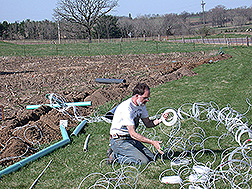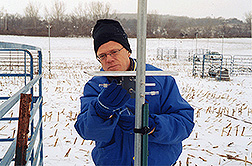A New Approach to Dairy Farming That’s “Out of Africa”
|
|
Sometimes, looking fondly on tradition and the ways things used to be is seen as being overly sentimental. Sometimes, it makes perfect sense.
At least that’s what agroecologist Mark Powell is finding in his search for better ways to manage a herd of Holsteins and the vast amounts of urine and manure the animals produce each year.
Nitrogen, phosphorus, and other nutrients excreted by the cows must end up somewhere in the environment—in water, air, plants, or soil—says Powell, who works at ARS’s U.S. Dairy Forage Research Center, in Madison, Wisconsin. He’s found a way to take advantage of manure’s natural plant nutrients to increase forage yields while helping to shield local waterways and groundwater against potential contamination. His approach might even improve animals’ overall health. Despite all these benefits, Powell’s method isn’t complicated or high-tech; it might be as old as agriculture itself.
Waste Not, Want Not
A single, average dairy cow produces 8 gallons of urine and an equal amount of manure every day. What might be viewed as a smelly liability to some land and livestock managers is a precious commodity to farmers in Sub-Saharan Africa, says Powell.
He spent 15 years in West Africa watching animals be fed and watered solely, in some cases, for the nutrient-rich manure they could provide. “Those farmers didn’t have access to fertilizers or feed supplements like American farmers do,” Powell says. “The manure that came from the herds they managed was the only resource they had for maintaining soil fertility.”
Not wanting to forego any of it, the African farmers took an age-old approach to placing the nutrients where they’re needed.
“African herdsmen gather, or corral, their animals directly onto croplands at night between crop cycles. That way, all the animals’ dung and urine is immediately delivered to the soil, enriching it for future crops and vegetation,” Powell says.
The farmers, without access to technical training or extension advice, were on to something. The manure and urine delivered directly to the soil—and tilled by way of the animals’ hooves and weight—helped African farmers enjoy a twofold increase in sorghum and millet production, an effect that can last 2 to 3 years.
A Daily Shuttle
The traditional African way of managing animals and their valued manure is in sharp contrast to the system used by many dairy farmers in the United States. Powell says that about two-thirds of midwestern and northeastern U.S. dairy farmers manage manure through a daily haul system in which herds are fed mostly in confinement and their manure is shuttled out to fields.
“When animals are confined to the barn, you can only recover part of the manure’s nutrients,” says Powell. “Much of the nitrogen in urine is lost in the barn.”
And it’s that nitrogen, Powell says, that is making all the difference. In studies with soil scientist Michael Russelle, who works in ARS’s Plant Science Research Unit at St. Paul, Minnesota, Powell is finding that plants’ nitrogen uptake is 35 to 50 percent higher in plots where heifers are corralled than in plots where barn manure is simply spread.
“The urine helps nutrient uptake,” he says, “not only by providing additional nitrogen, but also by decreasing the soil’s acidity, making important phosphorus nutrients more available to plants. After urine, which has a pH of about 8, hits soil with a pH of 5 to 6, the soil’s overall pH is raised to around 7 for a week or two. This higher pH unlocks phosphorus in the soil, and plant roots can more readily use it.”
The corralling approach is best suited for small- and medium-sized dairy operations; but as Powell points out, at least half the country’s dairy farms fall into this category.
Interested farmers would just need to move their animals to different, rotating fields that are slated for growing a forage crop, like corn or alfalfa. A movable electric fence can be used to keep the animals in the targeted area. Cows are gradually moved, several feet at a time, to allow manure and urine to reach different parts of the field.
|
|
Spare the Streams
The more commonly practiced daily-haul approach not only wastes potentially valuable fertilizer, it may also create nutrient “hot spots” that pose a threat to nearby and distant aquatic environments. Powell says this issue is important, since many historic U.S. dairy farmsteads are located next to water sources, like streams or springs.
Without aid of the animals’ natural tilling effects—provided by the corralling approach—nutrients in the manure may be more prone to runoff. Excess phosphorus can put marine and freshwater systems into overdrive by stoking extensive algal blooms that suck vital oxygen from the water when the algae die.
At their research farm in Prairie du Sac, Wisconsin, Powell and Russelle are also studying how much nitrogen from the animals’ manure enters the atmosphere as ammonia gas, potentially harming air quality, and how much leaches below the root zone, threatening groundwater quality.
Russelle says that “compared to daily hauling, direct deposit of manure by heifers conserves ammonia and does not increase nitrate leaching. The direct-deposit practice retains nitrogen in the soil for the next crop, which lowers fertilizer needs and reduces damage to the environment from nitrogen losses.”
Healthy Cows, Happy Consumers
Economics alone might make Powell’s method look more attractive to dairy farmers if they’re not impressed by its other benefits.
“Nitrogen fertilizer has almost doubled in price in the past 2 years,” he says. “By corralling, farmers could take advantage of more of the nitrogen in animal manure. They could also save on costs associated with the labor, time, and fuel needed to scrape manure out of barns and spread it on fields.”
And, according to some dairy farmers, with more time outside—especially in dry, cool air—the animals may enjoy better health, including fewer udder-related ailments. That could mean lower veterinary bills for farmers.
“In Wisconsin and surrounding states,” Powell says, “there’s no reason that nonlactating cows and calves can’t be outdoors most of the year. A lot of dairy farms will keep their herds outside, especially on nice days. But on most farms, they’re kept in designated areas that never change and can become sources of nutrient runoff and leaching.” The corralling approach would move the cows around the farm, preventing nutrient buildup.
The other bonus to all this? “People like to see dairy cows outside,” says Powell, “rather than know they’re confined indoors. It’s pleasing to see cows grazing and resting in fields.”—By Erin K. Peabody, Agricultural Research Service Information Staff.
This research is part of Manure and Byproduct Utilization (#206) and Integrated Farming Systems (#207), two ARS National Programs described on the World Wide Web at http://www.ars.usda.gov/research/programs.htm.
J. Mark Powell is with the USDA-ARS U.S. Dairy Forage Research Center, 1925 Linden Dr. West, Madison, WI 53706; phone (608) 890-0070, fax (608) 890-0076.
Michael P. Russelle is in the USDA-ARS Plant Science Research Unit, 1529 Gortner Ave., St. Paul, MN 55108; phone (612) 625-8145, fax (651) 649-5058.
"A New Approach to Dairy Farming That’s “Out of Africa”" was published in the September 2005 issue of Agricultural Research magazine.









